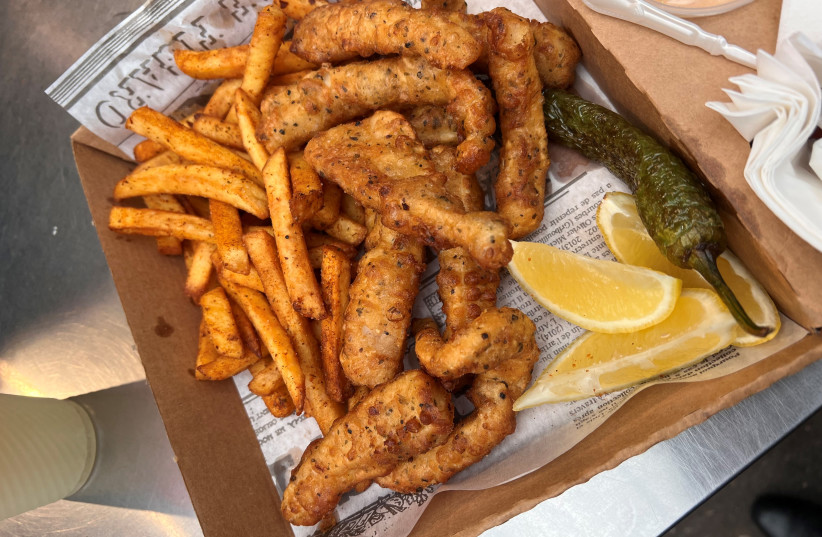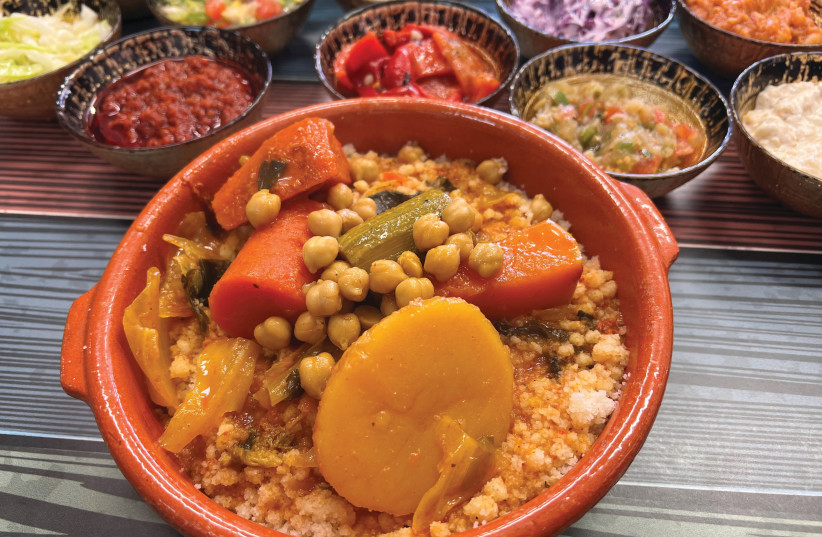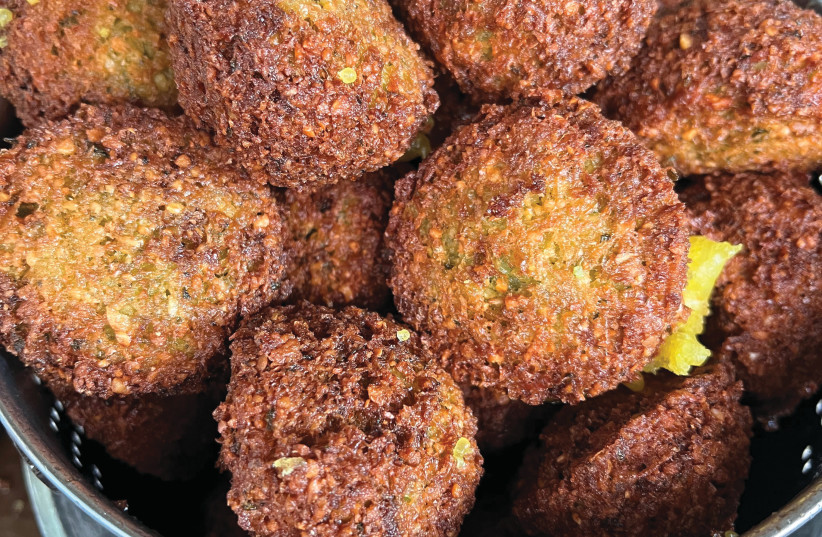Pascale’s Kitchen: Beersheba’s storied shuk

The shuk in Beersheba is somewhat of a time capsule, a meeting of different cultures, where people with different stories mingle as they peddle their wares.
Before COVID threw us for a loop, I used to love going to the shuk. No matter what area of Israel I was in, I would seek out the local outdoor market, and then wander around, smelling the herbs and tasting the fresh fruits and vegetables on offer. I love hearing merchants yelling out the prices of their wares.
Recently, I heard that the shuk in Beersheba was going to be given a face-lift, so I decided to quickly do a tour there before everything would change, and check out the plans for its massive renovation.
For more of Pascale's recipes, click here>>
The shuk in Beersheba is somewhat of a time capsule, a meeting of different cultures, where people with different stories mingle as they peddle their wares. The market is located near the northern bank of Nahal Beersheba and one of the city’s largest intersections. In 1961, the current shuk was established, merging all the outdoor markets that existed in Beersheba at the time. In the past, the Bedouin shuk had stood on that spot.
After the War of Independence, the IDF forbade Bedouin from entering Beersheba, so the Bedouin shuk was shut down, and a ma’abara (transit camp for new immigrants) was constructed there to absorb new immigrants to the fledgling country. In 1954, the Bedouin returned to that spot and reopened their outdoor market stalls, and the shuk once again became the central market for fruit, vegetables and all sorts of housewares at low prices.
Thousands of people would flock to the Bedouin shuk to purchase clothing, spices and anything else they needed for their families and homes. Then, in the late 1960s, the Beersheba Municipality decided to merge all of the city’s outdoor markets into one large and organized shuk. Nowadays, the shuk is comprised of four sections. In the first section, shoppers can find clothing, shoes and jewelry. The second offers fruit, vegetables, fish and meat. The third sells items for the Bedouin community.
The market was built in a U shape, in an effort to maintain the shape of the original Bedouin market. The fourth section was meant to contain fruit and vegetables but was never built, since remains of a floor from an ancient Byzantine-era church were discovered there.
Recently, the city decided to revamp the market and turn it into a modern culinary center that would attract local and foreign visitors alike. The plan is to construct a market that would provide enough space for culinary tours to be held there. Apparently, construction at the site will begin soon after Passover. It is being overseen by the municipality, in cooperation with the local merchants’ council and the municipal company for business development in Beersheba, at an estimated cost of NIS 1 million. The new shuk will be the largest outdoor market in Israel.
I BEGAN my tour of the soon-to-be destroyed shuk at Tavlinei Maimon, my favorite spice stall. Tani Maimon opened his business in the 1950s in the Tzrifonim Market, and his stall is an almost exact copy of his father’s spice business back in Tunis. He sells hundreds of types of spices, olive oil, legumes and grains.
Next, I wanted to buy some fish, so I moved on to the Iluz family’s restaurant, where you can buy fish ‘n chips on the spot in spicy batter, served with fries, spicy peppers and a lemon wedge. You can also buy a plate of the freshest chraimeh (spicy North African fish) you’ve ever had.
At the next stall, the vendor was roasting chestnuts right in front of us, and nearby a baker was making fresh bread, pita and challot for Shabbat. All along, we heard other merchants calling out their wares and prices in an effort to draw our attention to whatever they were selling.
Then we saw Ida’s restaurant – Halev Harahav – where you can dine on some of the best down-to-earth homemade food you’ve ever eaten. Ida makes couscous, chicken, humus, kubbeh, spicy fish and dozens of salads.
Then, all of a sudden, I saw people waiting patiently in a long line leading up to Jacques – Melech Hafalafel. It was founded in 1969 and is currently managed by Jacques’ grandson Johny and his wife. They still use his grandfather’s traditional secret recipe to make the best spicy and humongous falafel.
Nearby, we found Hummus Edna, where you can eat a scrumptious plate of humus with ful (fava beans). The owners opened the establishment four months ago and serve hummus throughout the week; on Fridays, they offer takeaway food for Shabbat. On Monday and Thursday afternoons, they turn the place into a hip hangout, with music and food that young people love.
Since I was already in Beersheba, I decided to check out a few other new food-based businesses in the city. The first one was La Patisserie, run by Idan Ben Baruch, who began selling desserts he made at home while he was in culinary school. Soon after, he began selling from a small place across the street. Two years ago, Ben Baruch expanded and is now considering opening a second branch in the city. Another impressive bakery is Très Jolie Patisserie, run by Moran Tabib-Zada, a chocolatier who was named best pastry chef in Israel last year.
The last stop on my day trip to Beersheba was in the Old City, which was built by the Ottomans, and has become a hipster place that many young people today call home. Many university students, musicians and artists live in the Old City, which has rejuvenated the area and brought lots of color.
Tucked in among the ancient stones, I found LiAmor, a studio run by chef Limor Amar, where she offers culinary workshops. Her specialty is hosting open meals that last four hours, in which up to 12 people enjoy a meal together with people they just met.
Throughout the day, I tried to lay on the charm in an effort to convince at least one vendor to share one of his or her tried-and-true recipes with me, but to no avail. They all held their cards (and secret recipes) close to their chest. Below, you’ll find recipes for chickpea couscous and falafel.
COUSCOUS BADAZ & CHICKPEAS
Makes 6-8 servings.
- 6 pieces of chicken
- 1 medium onion
- 8-9 celery stalks with leaves
- 2 large carrots
- 2 medium turnips
- 250 gr. pumpkin
- ½ head of medium cabbage
- 2 medium light green squash
- 2 potatoes
- 2 sprigs cilantro
- 2 Tbsp. oil
- 1 cup of dry chickpeas, soaked in water overnight
- ½ tsp. salt
- ½ tsp. pepper
- ¼ tsp. harissa or spicy paprika
The day before cooking, soak the chickpeas in water with a little baking soda. The next day, drain the chickpeas; chop the celery, onion and cilantro.
Heat the oil in a large pot. Add the chickpeas, chopped vegetables and sauté for 3-4 minutes. Add 9-10 cups of water. When it boils, add the chicken pieces.
Cut the rest of the vegetables into pieces, then add them, along with the salt, pepper and harissa. Cover the pot and cook over medium-low heat for 90 minutes.
Prepare the couscous ahead of time.
Level of difficulty: Medium/easyTime: 2 hours (not including soaking time)Status: Meat
FALAFEL BALLS
Makes 20 balls.
- 2 cups dry chickpeas, soaked in water overnight
- 5 sprigs of cilantro
- 6 sprigs of parsley
- 5 cloves of garlic
- 2 medium onions
- 2 tsp. cumin
- 1 tsp. salt
- ½ tsp. spicy paprika
- ¼ tsp. pepper
- ½ tsp. baking soda
- 3 tsp. water
The day before cooking, soak the chickpeas in water. The next day, rinse them and blend them in a food processor with the cilantro, parsley, garlic and onion until smooth.
Transfer the mixture to a bowl and add the rest of the ingredients, except for the oil, and mix well. Let the mixture sit for 20 minutes.
Take a bit of the mixture and create small balls.
Heat the oil in a deep pan and fry the balls until they turn golden brown. Remove and place on paper towels.
Level of difficulty: EasyTime: 1 hour (not including soaking time)Status: Parve
Translated by Hannah Hochner.
Jerusalem Post Store
`; document.getElementById("linkPremium").innerHTML = cont; var divWithLink = document.getElementById("premium-link"); if (divWithLink !== null && divWithLink !== 'undefined') { divWithLink.style.border = "solid 1px #cb0f3e"; divWithLink.style.textAlign = "center"; divWithLink.style.marginBottom = "15px"; divWithLink.style.marginTop = "15px"; divWithLink.style.width = "100%"; divWithLink.style.backgroundColor = "#122952"; divWithLink.style.color = "#ffffff"; divWithLink.style.lineHeight = "1.5"; } } (function (v, i) { });



